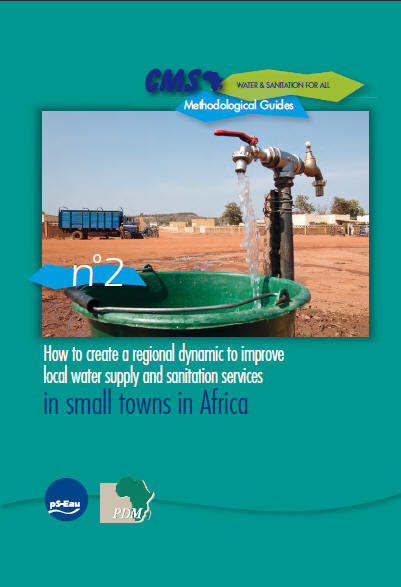CMS guide n°2: How to create a regional dynamic to improve local water supply and sanitation services in small towns in Africa
 |
Guide SMC n°2: Créer une dynamique régionale pour améliorer les services locaux d'eau potable et d'assainissement dans les petites villes africaines
livre , outil d'aide à la décision coll. Guide méthodologique n° 2 Nov 2010 ; 64 pages
Aut. Bruno Valfrey
Ed. PDM - Cotonou pS-Eau - Paris
Téléchargeable sous format: PdF
Site internet: www.pseau.org/smc
 CMS guide n°1: How to develop a concerted municipal strategy
for water and sanitation
CMS guide n°1: How to develop a concerted municipal strategy
for water and sanitation
 CMS Guide n°3: How to analyze the demand
of current and future users for water and sanitation services
in towns and cities in Africa
CMS Guide n°3: How to analyze the demand
of current and future users for water and sanitation services
in towns and cities in Africa
 CMS guide n°4: How to select appropriate technical solutions for sanitation
CMS guide n°4: How to select appropriate technical solutions for sanitation
 CMS guide n°5: How to manage public toilets and showers
CMS guide n°5: How to manage public toilets and showers
 CMS Guide n°6: Financing sanitation in Sub-Saharan Africa
Résumé:
CMS Guide n°6: Financing sanitation in Sub-Saharan Africa
Résumé:Les petites villes, dont la taille varie de 3 000 à 30 000 habitants, présentent des caractéristiques spécifiques, intermédiaires entre le milieu rural et le milieu urbain. Trop petites pour bénéficier des opportunités propres aux grands centres urbains, notamment en termes de compétences pour le développement et la gestion des services, elles sont en même temps trop grandes pour être adaptées aux approches communautaires prédominantes dans les zones rurales.
Ce guide définit les enjeux et défis spécifiques aux petites villes. Il propose une méthodologie pour construire une stratégie régionale pour l’eau et l’assainissement et fournit des pistes d’actions pour faciliter l’accès aux financements et mobiliser les besoins d’expertise en appui conseil et en formation à destination des collectivités locales et des exploitants des services. Abstract:
Small towns, the size of which can vary from between 3,000 and 30,000 inhabitants, have specific characteristics as they tend to be situated midway between rural and urban. Too small to benefit from those opportunities available to large urban centers, particularly in terms of competencies for developing and managing services, they are also too large to be able to accommodate those community-based approaches prevalent in rural areas.
This guide defines the specific issues and challenges facing small towns. A methodology for developing a regional strategy for water and sanitation is provided, as well as the courses of action to be followed to facilitate access to finance and mobilize the expertise required to provide back-up support and training to local authorities and service operators. Sommaire:
• le chapitre 1 met en évidence les principales problématiques liées au niveau régional et en propose une définition ;
• le chapitre 2 présente de manière détaillée les enjeux et attentes des acteurs en matière d’eau et d’assainissement au niveau régional ;
• le chapitre 3 propose une méthodologie d’intervention pour construire une stratégie régionale pour l’eau et l’assainissement ;
• le dernier chapitre propose des exemples concrets d’orientations stratégiques régionales qui ont été arrêtées dans les trois régions ciblées par le programme SMC. Contents:
• chapter 1 highlights the main issues and different opportunities associated with the regional level and provides a definition of what this regional level is;
• chapter 2 details stakeholders’ issues and expectations with regard to water and sanitation at regional level;
• chapter 3 sets out an intervention process that can be used to build a regional strategy for water and sanitation;
• the final chapter provides concrete examples of regional strategic orientations that have been selected in the three regions targeted by the CMS program.
Publics-Cibles:
Collectivité , Université , Animateur/Educateur , Acteurs de coopération , Technicien , Ingénieur, concepteur , Socio-économiste , Economiste
Mots clefs: |
accès à l'assainissement (CI) (DT) (OP) (ope) , accès à l'eau (CI) (DT) (OP) (ope) , Afrique (CI) (DT) (OP) (ope) , analyse socio-économique (CI) (DT) (OP) (ope) , approvisionnement en eau (CI) (DT) (OP) (ope) , aspects institutionnels (CI) (DT) (OP) (ope) , assainissement (CI) (DT) (OP) (ope) , assainissement autonome (CI) (DT) (OP) (ope) , collectivité locale (CI) (DT) (OP) (ope) , collectivité territoriale (CI) (DT) (OP) (ope) , coopération (CI) (DT) (OP) (ope) , coopération entre collectivités (CI) (DT) (OP) (ope) , décentralisation (CI) (DT) (OP) (ope) , développement urbain (CI) (DT) (OP) (ope) , distribution d'eau potable (CI) (DT) (OP) (ope) , financement (CI) (DT) (OP) (ope) , formation (CI) (DT) (OP) (ope) , gestion - management (CI) (DT) (OP) (ope) , maîtrise d'ouvrage (CI) (DT) (OP) (ope) , mode de gestion/gouvernance (CI) (DT) (OP) (ope) , opérateur (CI) (DT) (OP) (ope) , petits centres (CI) (DT) (OP) (ope) , population à faible revenus (CI) (DT) (OP) (ope) , service public de l'eau (CI) (DT) (OP) (ope) , services essentiels (CI) (DT) (OP) (ope) |
Editeurs/Diffuseurs: |
|
PDM
-
Partenariat pour le Développement Municipal - Cotonou - Bénin |
pS-Eau
-
Programme Solidarité Eau - Paris |
En cas de lien brisé, nous le mentionner à communication@pseau.org